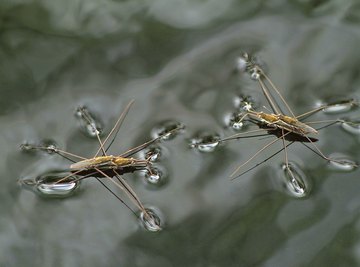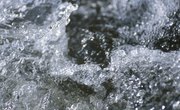
The water molecule is electrically neutral, but the asymmetric arrangement of the hydrogen atoms on the oxygen atom gives it a net positive charge on one side and a negative charge on the other. Among the important consequences for living organisms are water's ability to dissolve a variety of substances, more than any other liquid, and its strong surface tension, which allows it to form drops and to travel through tiny roots, stems and capillaries. Water is the only substance that exists as a gas, liquid and solid at temperatures found on Earth, and because of the polarity of the water molecule, the solid state is less dense than the liquid state. As a result, ice floats, and this has profound implications for life everywhere on the planet.
Hydrogen Bonding
An easy way to appreciate the polar nature of a water molecule is to visualize it as Mickey Mouse's head. The hydrogen atoms sit atop the oxygen molecule in much the same way that the ears sit on Mickey's head. This distorted tetrahedral arrangement comes about because of the way electrons are shared between the atoms. The hydrogen atoms form a 104.5-degree angle, giving each molecule the characteristics of an electric dipole or a magnet.
The positive (hydrogen) side of each water molecule is attracted to the negative (oxygen) side of surrounding molecules in a process called hydrogen bonding. Each hydrogen bond lasts only for a fraction of a second, and isn't nearly strong enough to break the covalent bonds between the atoms, but it gives water an anomalous nature when compared to other liquids, such as alcohol. Three anomalies are especially important for living organisms.
The Solvent of Life
Because of its polar nature, water is able to dissolve so many substances that scientists sometimes call it a universal solvent. Organisms absorb many essential nutrients, including carbon, nitrogen, phosphorous, potassium, calcium, magnesium and sulfur from water. Moreover, when water dissolves an ionic solid, such as sodium chloride, the ions float freely in solution and turn it into an electrolyte. Electrolytes conduct the electrical signals needed to transmit neural signals as well as those that regulate other biophysical processes. Water is also the medium through which organisms eliminate the waste products of metabolism.
The Binding Force of Nourishment
The electrostatic attraction of water molecules for each other creates the phenomenon of surface tension, whereby the surface of liquid water forms a barrier upon which certain insects can actually walk. Surface tension makes water bead up into droplets, and when one droplet approaches another, they attract each other to form a single droplet.
Because of this attraction, water can get drawn into small capillaries as a steady stream. This allows plants to draw moisture from the soil through their roots, and it enables tall trees to get nourishment by drawing sap through their pores. The attraction of water molecules for each other also helps keep fluids circulating through animal bodies.
The Anomaly of Floating Ice
If ice didn't float, the world would be a different place and probably wouldn't be able to support life. Oceans and lakes could freeze from the bottom up and could turn into a solid mass whenever the temperature turned cold. Instead, bodies of water form a skin of ice during the winter; the surface of the water freezes when exposed to the colder air temperatures above it, but the ice stays on top of the rest of the water because ice is less dense than water. This allows fish and other marine creatures to survive in cold weather and provide food for land-dwelling creatures.
Except for water, every other compound becomes denser in the solid state than it is in the liquid state. Water's unique behavior is a direct result of the polarity of the water molecule. As the molecules settle into the solid state, hydrogen bonding forces them into a lattice structure that provides more space between them than they had in the liquid state.
References
About the Author
Chris Deziel holds a Bachelor's degree in physics and a Master's degree in Humanities, He has taught science, math and English at the university level, both in his native Canada and in Japan. He began writing online in 2010, offering information in scientific, cultural and practical topics. His writing covers science, math and home improvement and design, as well as religion and the oriental healing arts.
